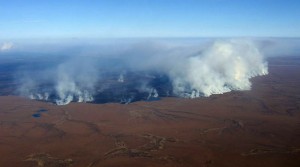Largest recorded tundra fire yields scientific surprises
July 29, 2011

907-474-7412
7/29/11
In 2007, the largest recorded tundra fire in the Arctic released approximately as much carbon into the atmosphere as the tundra has stored in the previous 50 years.
A study of the Anaktuvuk River fire on AlaskaŌĆÖs North Slope revealed how rapidly a single tundra fire can offset or reverse a half-century worth of soil-stored carbon. The studyŌĆÖs results are published in the July 28 issue of the journal Nature.
Tundra soils store huge amounts of carbon in the form of organic material. That carbon is hundreds to thousands of years old. The upper layers of the soil insulate the permanently frozen ground, called permafrost, below, and restrict fires to aboveground plants and plant litter. As arctic summers get warmer and dryer, so do the soils, which are highly flammable when dry. That allows the fires to burn more deeply into the ground. If those upper layers burn in a fire, that not only releases carbon into the atmosphere, is also speeds the thawing of the permafrost below. The once-frozen organic material in the permafrost can begin to decompose, releasing gases like carbon dioxide and methane, which in turn can amplify climate change.
ŌĆ£Fire has been largely absent from tundra for the past 11,000 or so years, but the frequency of tundra fires is increasing, probably as a response to climate warming,ŌĆØ said co-author Syndonia ŌĆ£DonieŌĆØ Bret-Harte, an ecosystem ecologist at the University of Alaska Fairbanks Institute of Arctic Biology. ŌĆ£If the frequency of these fires remains at long intervals, 80 to 150 years, then the tundra has time to recover. If these fires occur more frequently, say every 10 years or so, then the landscape cannot recover.ŌĆØ
The Anaktuvuk River fire burned 401 square miles, an area roughly the size of Cape Cod and visible from space, and released more than 2.3 million tons of carbon into the atmosphere. Radiocarbon dating of the soils revealed that the maximum age of the carbon released in the fire was 50 years.
ŌĆ£The amount of carbon released into the atmosphere from this fire is equivalent to the amount of carbon stored by the global tundra biome,ŌĆØ said lead author Michelle Mack, a biologist from the University of Florida. ŌĆ£This was a boreal forest-sized fire.ŌĆØ
The Anaktuvuk River fire was started by a lightning strike in July 2007.
ŌĆ£Normally we would expect the fire to go out in the moist soil, but this summer was so dry that the fire didnŌĆÖt go out and strong winds in September caused it to burn a very large area,ŌĆØ said Bret-Harte. The wall of smoke from the fire was visible 15 miles south at the Toolik Field Station, where the scientists were working.
In addition to the direct release of carbon into the atmosphere, tundra fires are important because of the potential effects on global climate change. ŌĆ£These fires could be a radical and very rapid positive feedback to atmospheric carbon dioxide,ŌĆØ said Mack.
According to the authors, their observations from the Anaktuvuk River fire support the idea that tundra fires have the potential to decrease terrestrial carbon stocks while releasing large amounts of carbon into the atmosphere, both of which stand to have a strong effect on global climate.
ADDITIONAL CONTACTS: Syndonia ŌĆ£DonieŌĆØ Bret-Harte, UAF, at 907-474-5434 or msbretharte@alaska.edu. Michelle Mack, University of Florida, 352-846-2510, mcmack@ufl.edu, Skype: michellecailinmack
ON THE WEB:
NOTE TO EDITORS: Syndonia ŌĆ£DonieŌĆØ Bret-Harte and Michelle Mack will both be at the Institute of Arctic Biology Toolik Field Station through early August. Email is the best means of contact.
Syndonia is pronounced . Donie is pronounced
MEG/7-29-11/024-12


